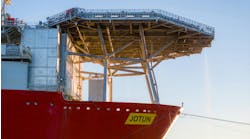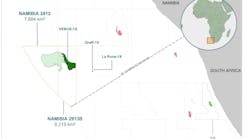A couple of months ago, spurred by the influx of ultra-deepwater drilling units,Offshore asked the rhetorical question, "How deep can we go?" A majority of newbuilds are rated for 12,000 ft (3,658 m) of water and 40,000 ft (12,195 m) of drilled hole. It looks like the industry is not about to run out of deepwater capable drilling units anytime soon.
But there is more to drilling record-setting boreholes than rig capability. As soon as rotary drilling made its debut around the turn of the last century, innovations to design better drill bits were introduced. People might think that rotary drill bit technology is pretty mature by now, but they would be amazed at the new ideas and innovations, many of which are featured in this issue.
Looking at the main driving factors of bit design, it is obvious that the deeper you go, the more costly it is to trip the pipe. Accordingly, considerable effort has been directed at extending bit life. If one round-trip can be avoided, rig time savings can be more than $1 million. In fact, many operators have found that extended life almost always trumps rate of penetration (ROP). Being able to drill fast is of little advantage if the bit wears out and a trip is necessary to make a bit change. Remember the old tale of the tortoise and the hare: a company that can drill a hole section on a single bit can save more rig time than one that delivers a higher ROP but must replace the worn bit halfway down.
I wrote an article about eight years ago about an operator drilling in the High Island area offshore Texas. The geocolumn was characterized by highly abrasive rocks, both in the 8½-in. intermediate hole and in the 6.0-in. pay zone section. On offset wells, drillers had consumed five bits in each section due to extreme wear. Hughes Christensen, the drill bit manufacturer, and Schlumberger, the LWD provider, suggested a solution. Like many LWD tools today, the telemetry sub also measures and transmits bit vibration signals in real time. Analyzing the vibration logs from offset wells revealed intense bit whirl, bit bounce, and stick-slip vibration while drilling the abrasive sections. Hughes Christensen suggested a bit specially-designed for tough conditions, and Schlumberger set up to monitor bit vibration and transmit the data to the operator's offices in Houston in real time. With 24/7 surveillance, drilling engineers were able to adjust rotation speed, weight-on-bit, and mud weight to mitigate the vibration or eliminate it altogether. The result was spectacular. Even though overall ROP was less than that of the offset wells, both the 8½-in. and 6.0-in. sections were drilled with one bit each, saving an estimated $2.5 million.
Mitigating bit vibration is a good way to improve overall drilling efficiency as well as bit life. In ultra-deepwater, with ultra-deep boreholes, eliminating a single bit trip can save much more than drilling at maximum ROP.
Unfortunately, drillers are not always able to totally eliminate vibration or the resulting bit wear. In this issue, a new bit design that features 360° rolling cutters is described. It is unnecessary to replace 100% of the cutters with the new design—only those in high-wear areas. Recently a bit with only 42 standard cutters was given new life by replacing seven strategically-selected cutters based on wear to deliver spectacular drilling efficiency and extended bit life. The rolling cutter continually presents a fresh cutting edge to the formation using all 360° of the cutter. Users report a 50% improvement in every performance parameter.
Other innovators are addressing the challenges of transition drilling. Faced with alternating hard and soft layers, it is hard to choose the best solution. Bits designed for soft rock have actually had blades break off when they strike a hard streak. The new MegaForce matrix body bits from Halliburton address transition drilling two ways. The bit matrix has greatly reinforced blades, and the bit takes advantage of the new SelectCutter design that exhibits 40% greater impact and abrasion resistance, along with increased high-temperature performance. By toughening up the bits' structures and changing to better cutters, the company was able to provide a bit that could drill highly layered formations efficiently, with greatly extended bit life.
While improvements in cutter and matrix design have delivered significant advantages, bit hydraulics play a major role in achieving drilling efficiency. Unless cuttings are properly swept from the rock face, and unless there is adequate junk slot area to conduct them up and away from the bit, valuable energy is wasted re-grinding the cuttings instead of breaking new rock. The ability to tie all bit design parameters together and consider them collectively as a system has been provided by powerful design software and CAD-CAM renderings that can create customized designs and configurations to solve specific drilling challenges. Most bit manufacturers use these programs extensively. A key feature of bit design software is simulation. Engineers can enter or modify virtually any parameter and simulate the result.
Are you old enough to recall the old belt-driven dentist's drills? These medieval torture instruments with their low rpm are a thing of the past. The drilling industry has addressed the challenge of rpm, which can create severe drillstring vibration. By placing a straight mud motor in the bottomhole assembly just above the bit, mud power can spin the bit at high rpm, dramatically improving drilling efficiency. Meanwhile the top drive can be slowed to a more sedate speed that reduces both wear and vibration of the entire drillstring.





